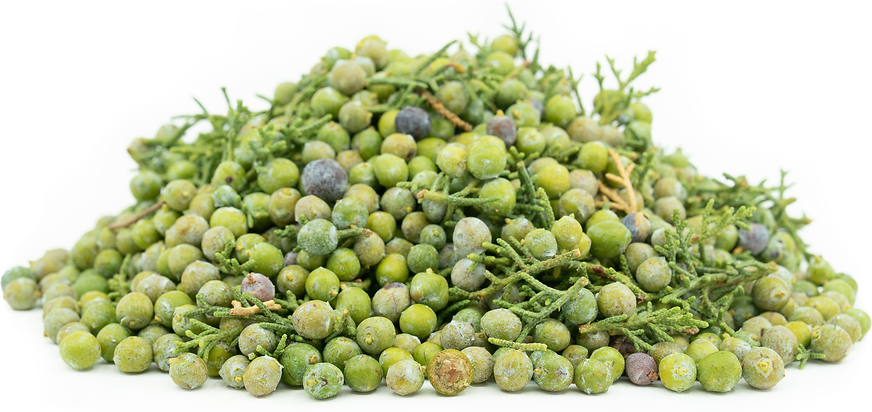


Juniper Berries
Estimated Inventory, 1 oz : 5.00
This item was last sold on : 06/07/25
Description/Taste
The variety of Juniper berries most often used in culinary applications grow on low sprawling bushes that open to an irregularly shaped crown. Only the female tree makes the berries, while the male just has little brown cones. The small berries have a dark blue color with a silver bloom and very firm texture. Juniper berries offers a sharp flavor similar to rosemary but with sweet citrus undertones and a turpentine-like finish.
Seasons/Availability
Juniper berries are typically foraged in the late summer and early fall.
Current Facts
Juniper berries grow on the evergreen shrub that is botanically classified as Juniperus communis and a member of the Cypress Family. With more than 60 varieties growing world-wide, they are a widely varying plant and range from low creeping ground cover to tall upright trees. It is inaccurate to call the fruits berries, as they are actually cones with scales so miniature and packed down that they merely appear to be a smooth round berry. It is important to be sure of proper identification as not all varieties are edible. Some commonly grown edible cultivars include, Aurea, Compressa and Blueberry Delight™.
Nutritional Value
Juniper berries are good source of vitamin C. They also contain flavonoids, resin and sugars. The oil of the Juniper berry is used as a diuretic and in the treatment of stomach aches and indigestion. They are a powerful detoxifier and used as an aid to stimulate the kidneys and bladder.
Applications
Juniper berries may be used fresh, but are very commonly found in the dried form. Once ripe, they are collected in baskets and laid out to dry, losing some of the bluish bloom in the process and turning a more blackish color. Once dried, the berries can be used whole or crushed to release more of their flavor. Juniper berries are a popular seasoning for game meats and in sausage preparations. Used in savory dishes, they may be added to the brine for corned beef and sauerkraut. Store the dried berries in a jar of sugar to infuse flavor for later use in confections or as a beverage sweetener. Juniper berries areprevalent in European cuisine, such as meat stews, juniper tea, and sauces. At most, three or four berries are used for flavoring a dish.
Ethnic/Cultural Info
Juniper berries are responsible for not just the flavor of gin, but also the name. Gin was originally known as jenever (juniper) in the Netherlands, where it was first produced.
Geography/History
Juniper bushes are native to the northern latitudes of Europe, Asia and North America. They are one of the most widely distributed shrubs and have a history that can be traced to all corners of the globe. Evidence of Juniper berries have been uncovered in the Ancient Egyptian tomb of King Tut. They were used by Romans for medicinal purposes and the Greek warriors ate them raw to boost stamina. The Comanche and Lakota Native American tribes used them as a food source as well as in natural medicine. Juniper typically prefers open, sunny locations in light, sandy with adequate drainage.
Recipe Ideas
Recipes that include Juniper Berries. One




